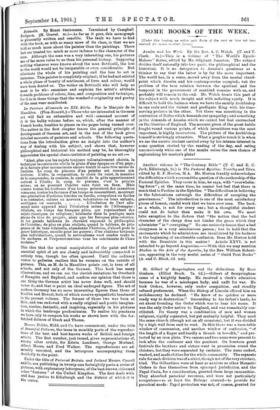La Painters Allemande an III. Siecle. Par le Marquis de
la Mazeliere. (Plon-Nourrit.)—Those who are interested in German art will find an exhaustive and well - reasoned account of it in the bulky volume before us, which, after the manner of French books, tumbles to pieces on the pages being turned over. The author in the first chapter traces the general principle of development of German art, and in the rest of the book gives detailed accounts of painters and schools. The following quota- tions from the introduction gives an insight into the author's way of dealing with his subject, and shows that, however philosophical and historical his method may be, he thoroughly appreciates the special characteristics of painting as an art :-
"Ainsi, plus que lee sujets tonjours volontairement choisis, la technique inconsciente revele le genie d'itne époque ou d'un pays ; et la facture plus inconsciente encore trahit le caractere meme de radiate. Le coup de pinceau d'un peintre eat comma son ecriture. L'idee, la composition, le choir du sujet, in maniere de le comprendre, la couleur, la qualite de la pate appartiennent
surtont recole; le coup de pinceau, c'est le peintre meme; on ne pourrait rimiter sans faire un faux. Mils creme tontes lea ecritures d'un temps presentent des caracteres COMM11118, toutes lea factures d'un temps se ressemblent, montrant une generation &artistes timides on hardis, scrupulous on belles a se contenter, mimes ou nervous, volontatres on bons enfants, ascetiques on sensuels L'evolution de l'art alle- mend nous apprend ainsi revolution memo de l'Allemagne : idealiste, an temps des fresques pales, qui representent des snjets classiques on religieux ; hesitante dant, la pratique mais pleine du reve du progres, alors quo lea fresques plus colorees, et lea grands tableaux de chevalet exposent la philosophie de l'histoire; de plus en plus realiste, quand le tableau, de pate grease et de tons eclatants, abandonne rhistoire, d'abord pour le genre historique, ensuite pour lea genres ; d'un realisme toujours plus individualiste, quand le naturalisme vent rendre toute is vie moderne et rimpressionnisme tons lea sentiments de Fame moderne."
This idea that the actual manipulation of the paint and the essential spirit of art are closely and indissolubly connected is entirely true, though too often ignored. Until the ordinary visitor to galleries realises this he remains on the outside of pictures. This, as M. de la Mazaliere points out, is true of all schools, and not only of the German. This book has many illustrations, and we can see the slavish imitations by Overbeck of Ferngino and Raphael, and confirm our opinion that there is one thing the German artist has never done well, and should never do, and that is paint an ideal undraped figure. The art of modern Germany has no more interesting figures than those of Rocklin and Menzel, both of which receive sympathetic treatment in the present volume. The former of 'these two was born at Bale, and was endowed with a really original and poetic imagina- tion, sombre, fantastic, and inspiring, especially in his pictures in which the landscape predominates. To realise his greatness we have only to compare his works as shown here with the far. fetched dulness of Stuck and Thome.
Messrs. Dobbs, Kidd, and Co. have commenced, under the title of Beautiful Pictures, the issue in monthly parts of the reproduc- tions of the best and best-known works of British and foreign artists. The first number, just issued, gives representations of, among other artists, Sir Edwin Landseer, George Morland, Albert Moore, and Fred Walker. The reproductions are ad- mirably executed, and the letterpress accompanying them decidedly to the point.
Under the title of Pictorial Britain and Ireland Messrs. Cassell and Co. are publishing in twenty-one fortnightly parts a series of Pictures, with explanatory letterpress, of the best-known cities and other "features '' of the United Kingdom. The first deals with and does justice to Edinburgh and the district of which it is the centre.






































 Previous page
Previous page